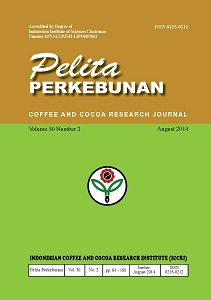Distribution of Radopholus similisand Pratylenchus CoffeaeNematodes in Coffee Plantation

Main Article Content
Abstract
A research to evaluate the difference of damage levels caused by two species nematodes, Radopholus similis and Pratylenchus coffeae on Arabica and Robusta coffee which were planted in the same endemic area have been conducted at Kalibendo (700 m asl. climate type B) and Blawan coffee estate (1200 m asl., climate type D) for two years. The results showed that in the medium highland (700 m asl.) R. similis attacked Arabica coffee with necrotic root scale higher than surface Robusta coffee. Distribution of R. similis population in the 50 cm depth below soil surface was likely with their root distribution. On the other hand P. coffeae in 30 cm depth below soil therefore their resistance to R. similis was more likely due to the escape reason, as result of their different distribution population of those species in different depth. Key words : Radopholus similis, Pratylenchus coffeae, Arabica coffee, Robusta coffee, distribution population.
Article Details
How to Cite
Hulupi, R., ., M., & Andayani, B. (2006). Distribution of Radopholus similisand Pratylenchus CoffeaeNematodes in Coffee Plantation. Pelita Perkebunan (a Coffee and Cocoa Research Journal), 23(3). https://doi.org/10.22302/iccri.jur.pelitaperkebunan.v23i3.41
Issue
Section
Articles

This work is licensed under a Creative Commons Attribution-NonCommercial 4.0 International License.
Authors who publish with this journal agree to the following terms:
- Authors retain copyright and grant the journal right of first publication with the work simultaneously licensed under a Creative Commons Attribution License that allows others to share the work with an acknowledgement of the work's authorship and initial publication in this journal.
- Authors are able to enter into separate, additional contractual arrangements for the non-exclusive distribution of the journal's published version of the work (e.g., post it to an institutional repository or publish it in a book), with an acknowledgement of its initial publication in this journal.
- Authors are permitted and encouraged to post their work online (e.g., in institutional repositories or on their website) prior to and during the submission process, as it can lead to productive exchanges, as well as earlier and greater citation of published work (See The Effect of Open Access).

